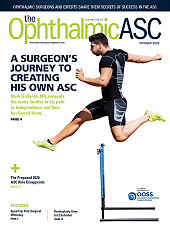Bernie Iliakis is the president and CEO of CorneaGen, leading all aspects of the organization since 2020. Over his career, he has been responsible for the distribution of more than 300,000 sight-restoring corneal grafts to over 50 countries worldwide.
Ophthalmology Management: Can you discuss the growing momentum of CTAK to treat keratoconus?

Bernie Iliakis: CorneaGen commercially launched Corneal Tissue Addition for Keratoplasty (CTAK) in June 2024. CTAK offers an advanced solution for contouring keratoconic eyes to significantly improve sight for patients in need. Using CorneaGen’s custom tissue inlays, CTAK provides patient-ready, gamma-irradiated sterile, non‑immunogenic donated corneal tissue inlays that are laser-cut and customized to patients’ specific severity and cone location. Invented by Drs. Peter Hersh, Steven Greenstein, and John Gelles more than a decade ago, CTAK can also return functional vision to the patient—the clinical trial showed 3 lines BCVA, and without correction, up to 6 lines of improvement. Many surgeons have relayed to us that this is one of the most exciting, innovative advances that they can bring to their practice. As of September 2025, we are celebrating our 1,000th procedure in the United States, and we have brought CTAK to the international market.
OM: How has eye banking evolved to better meet the needs of surgeons/patients?
BI: From the first corneal transplant in 1905, all the way to about 2000, it was all just full-thickness corneal transplant. But it has significantly evolved, to where eye banks have become much more involved in the tissue processing and thus the surgical process of corneal transplantation. With the advent of Descemet stripping automated endothelial keratoplasty (DSAEK) and Descemet membrane endothelial keratoplasty (DMEK), the processing and preparation of this transplant tissue went to the eye bank instead of surgeons. The benefit of that is that you can increase the quality and consistency of the processed tissue vs the individual surgeon processing that tissue.
At CorneaGen, we prepare the tissue to whatever thickness a surgeon prefers—anywhere from under 50 microns to whatever is needed for the patient. That saves surgeons OR time, eliminating the need to spend time precisely cutting and preparing the tissue for surgery, which also greatly reduces the risk of tissue wastage.
OM: How is CorneaGen meeting the growing demand for DMEK and DSAEK tissue processing?
BI: One of the main reasons CorneaGen was created was to see how we could make these innovations even better. So not only offering highly customized cutting of the tissue for DSAEK on the microkeratome, but CorneaGen can also finely prepare the peel Descemet membrane for DMEK surgery. We do this all at scale. The next advancement was to improve the quality and surgical delivery of tissue. Thus the advent of the Endoserter with preloaded DSAEK tissue as well as preloaded DMEK tissue in a Geuder glass cannula—both preserving quality of tissue and saving time for surgeons in the OR.
In addition, we were also the first eye bank to put amphotericin B, an antifungal, into the storage media to reduce the risk of fungal infection. And we are also the first bank to cut tissue on the femtosecond laser for shaped grafts. With CTAK, we are using femtosecond laser to custom-shape stromal tissue. We’re very proud to be one of the organizations to pioneer many of the innovations in the cornea space.
OM: You recently celebrated your 30th anniversary. What have been the most rewarding aspects of your career?
BI: From starting out as an eye bank technician—managing the family consent process and recovering eye tissue myself back in 1995—all the way to having the honor to lead the organization now, I’ve been blessed to be able to do the work that I do at CorneaGen.
One of the best things about working at CorneaGen is the people. We have 200 employees who are dedicated to what we are doing in the cornea transplant space and beyond. In addition, I’ve had a great opportunity to work and interact with surgeons and researchers worldwide.
Another aspect of the work that I find important is that we still share segments of donor family and recipient letters, which is at the core of what we do. This work is very personal for me, because I am also a donor family myself. I donated my father’s corneas back to his homeland in Greece, to the island of Crete. So, there are two recipients in his homeland with restored sight because of his generous donation. OM








